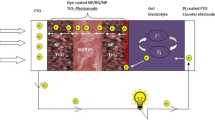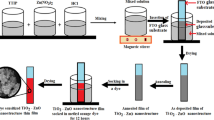Abstract
In this study, synthesis of nanosized TiO2 in which hydrolysis and polycondensation of precursor, Ti(OC4H9)4, has been performed in presence of different molecular weight polyethylene glycol (PEG) polymer as a capping agent is reported. Three different capped materials (TN-P400, TN-P4000, and TN-P8000) were synthesized along with un-capped TiO2 (TiO2 synthesized without using PEG, TN) for the sake of comparison. The structure and morphology of the synthesized TiO2 were characterized by XRD, FTIR, SEM, and DLS analyses. The X-ray diffraction spectrums show the presence of anatase phase TiO2. The as-synthesized PEG-capped TiO2 were used as photoanode material for dye-sensitized solar cells (DSSC) after coating with sensitizer dye N719, and photoelectric conversion efficiency (PCE) of 2.52%, under the illumination of 100 mW cm−2, has been achieved with TN-P8000, which was much improved compared with DSSC performance with un-capped TiO2 (PCE = 1.02%). EIS analyses revealed that TN-P8000 photoanode–based cell exhibited facile charge transfer, enhanced electron lifetime, and greater charge collection efficiency that contributed better photovoltaic performance. The results demonstrated that using PEG as a capping agent is a potential approach for improving the efficiency of DSSC and current conversion efficiency was increased as the molecular weight of PEG was increased.

Graphical abstract








Similar content being viewed by others
Change history
07 August 2020
The author would like to add <Emphasis Type="Bold">Acknowledgements in the originally published paper</Emphasis>
References
Kannan N, Vakeesan D (2016) Solar energy for future world: - a review. Renew Sust Energ Rev 62:1092–1105
Lewis NS (2016) Research opportunities to advance solar energy utilization. Science 351(6271):aad1920. https://doi.org/10.1126/science.aad1920.22
Regan BO, Gratzel M (1991) A low cost, high-efficiency solar cell based on dye- sensitized colloidal TiO2 films. Nature 353(6346):737–740
Grätzel M (2009) Recent advances in sensitized mesoscopic solar cells. Acc Chem Res 42(11):1788–1798
Kumbar MN, Sannaikar MS, Shaikh SKJ, Kamble AA, Wari MN, Inamdar SR, Qiao Q, Revanna BN, Madegowda M, Dasappa JP, Kamble RR (2018) Synthesis, Photophysical and computational study of novel coumarin-based organic dyes. Photochem Photobiol 94(2):261–276
Shah SAA, Sayyad MH, Nasr N, Toor RA, Sajjad S, Elbohy H, Qiao Q (2017) Photovoltaic performance and impedance spectroscopy of a purely organic dye and most common metallic dye based dye-sensitized solar cells. J Mater Sci Mater Electron 28:6552–6559
Maurya IC, Senapati S, Singh S, Srivastava P, Maiti P, Bahadur L (2018) Effect of particle size on the performance of TiO2 based dye-sensitized solar cells. ChemistrySelect 3(34):9872–9880
Neetu, Maurya IC, Singh S, Gupta AK, Srivastava P, Bahadur L (2017) N/Al-incorporated TiO2 nanocomposites for improved device performance of a dye-sensitized solar cell. ChemistrySelect 2(15):4267–4276
Ramakrishnan VM, Natarajan M, Santhanam A, Asokan V, Velauthapillai D (2018) Size controlled synthesis of TiO2 nanoparticles by modified solvothermal method towards effective photo catalytic and photovoltaic applications. Mater Res Bull 97:351–360
Javed HMA, Que W, Yin X, Kong LB, Iqbal J, Mustafa MS (2019) Investigation on the surface modification of TiO2 nanohexagon arrays based photoanode with SnO2 nanoparticles for highly-efficient dye-sensitized solar cells. Mater Res Bull 109:21–28
Abraham N, Rufus A, Unni C, Philip D (2018) Dye sensitized solar cells using catalytically active CuO-ZnO nanocomposite synthesized by single step method. Spectrochim Acta A Mol Biomol Spectrosc 200:116–126
Marimuthu T, Anandhan N, Thangamuthu R (2018) Electrochemical synthesis of one-dimensional ZnO nanostructures on ZnO seed layer for DSSC applications. Appl Surf Sci 428:385–394
Zhuang S, Lu M, Zhou N, Zhou L, Lin D, Peng Z, Wu Q (2019) Cu modified ZnO nanoflowers as photoanode material for highly efficient dye sensitized solar cells. Electrochim Acta 294:28–37
Chen SG, Chappel S, Diamant Y, Zaban A (2001) Preparation of Nb2O5 coated TiO2 nanoporous electrodes and their application in dye-sensitized solar cells. Chem Mater 13(12):4629–4634
Gómez LD, Rodríguez-Páez JE (2019) Micro/nanoscale mesoporous Nb2O5 particles: effect of synthesis conditions and doping with N, C, or S on their properties. Nano-Structures and Nano-Objects 17:43–57. https://doi.org/10.1016/j.nanoso.2018.11.002
Ücker CL, Gularte LT, Fernandes CD, Goetzke V, Moreira EC, Raubach CW, Moreira ML, Cava SS (2019) Investigation of the properties of niobium pentoxide for use in dye-sensitized solar cells. J Am Ceram Soc 102:1884–1892
Wang YF, Luo QP, Ding Y, Wang X, Li XF, Li DJ (2018) Hydrothermal preparation of hierarchical SnO2 microsphere for efficient dye-sensitized solar cells. Mater Chem Phys 207:141–146
Wang D, Liu S, Shao M, Li Q, Gu Y, Zhao J, Zhang X, Zhao J, Fang Y (2018) Aqueous solution-processed multifunctional SnO2 aggregates for highly efficient dye-sensitized solar cells. Ind Eng Chem Res 57(21):7136–7145
Tasić N, Stanojević ZM, Branković Z, Lačnjevac U, Ribić V, Žunić M, Novaković T, Podlogar M, Branković G (2016) Mesoporous films prepared from synthesized TiO2 nanoparticles and their application in dye-sensitized solar cells ( DSSCs ). Electrochim Acta 210:606–614
Shen Z, Jin S, Hao H, Hou H, Zhang G, Bi J, Yan S, Gao W, Liu G (2019) Synthesis and characterization of Sm 3+-doped barium stannate down-conversion nanocrystals and its application in dye-sensitized solar cells. Mater Chem Phys 230:215–220
Noman MT, Ashraf MA, Ali A (2019) Synthesis and applications of nano-TiO2: a review. Environ Sci Pollut Res 26(4):3262–3291
Ramakrishnan VM, Sandberg S, Muthukumarasamy N, Kvamme K, Balraju P, Agilan S, Velauthapillai D (2019) Microwave-assisted solvothermal synthesis of worms-like TiO2 nanostructures in submicron regime as light scattering layers for dye-sensitized solar cells. Mater Lett 236:747–751
Hussain MN, Shah SM, Shabir G, Bhatti AS, Badshah A, Bahadur A, Saboor A, Iqbal S, Khan K (2019) Iron and nickel doped tin (IV) oxide nanosheets: synthesis, characterization and applications in hybrid solar cells. Physica E Low Dimens Syst Nanostruct 108:307–316
Asghar MN, Anwar A, Rahman HMA, Shahid S, Nadeem I (2019) Green synthesis and characterization of metal ions-mixed titania for application in dye-sensitized solar cells. Toxicol Environ Chem 100:659–676
Ghann WE, Kang H, Uddin J, Chowdhury FA, Khondaker SI, Moniruzzaman M, Kabir MH, Rahman MM (2019) Synthesis and characterization of reduced graphene oxide and their application in dye-sensitized solar cells. ChemEngineering 3(1):7. https://doi.org/10.3390/chemengineering3010007
Wang CT, Lin HS, Wang WP (2019) Hydrothermal synthesis of Fe and Nb-doped titania nanobelts and their tunable electronic structure toward photovoltaic application. Mater Sci Semicond Process 99:85–91
Dubey RS (2018) Temperature-dependent phase transformation of TiO2 nanoparticles synthesized by sol-gel method. Mater Lett 215:312–317
Liu Z, Jian Z, Fang J, Xu X, Zhu X, Wu S (2012) Low-temperature reverse microemulsion synthesis, characterization, and photocatalytic performance of nanocrystalline titanium dioxide. Int J Photoenergy 2012:1–8. https://doi.org/10.1155/2012/702503
Mir N, Lee K, Paramasivam I, Schmuki P (2012) Optimizing TiO2 nanotube top geometry for use in dye-sensitized solar cells. Chem Eur J 18(38):11862–11866
Wu F, Zhou Z, Hicks AL (2019) Life cycle impact of titanium dioxide nanoparticle synthesis through physical, chemical, and biological routes. Environ Sci Technol 53(8):4078–4087
Wu HP, Lan CM, Hu JY, Huang WK, Shiu JW, Lan ZJ, Tsai CM, Su CH, Diau EWG (2013) Hybrid titania photoanodes with a nanostructured multi-layer. J Phys Chem Lett 4(9):1570–1577
Wang X, Li H, Liu Y, Zhao W, Liang C, Huang H, Mo D, Liu Z, Yu X, Deng Y, Shen H (2012) Hydrothermal synthesis of well-aligned hierarchical TiO2 tubular macrochannel arrays with large surface area for high performance dye-sensitized solar cells. Appl Energy 99:198–205
Mo LE, Li ZQ, Ding YC, Gao C, Hu LH, Huang Y, Hayat T, Alsaedi A, Dai SY (2019) Facile synthesis of TiO2 microspheres via solvothermal alcoholysis method for high performance dye-sensitized solar cells. Sol Energy 177:448–454
Raveendran P, Fu J, Wallen SL (2003) Completely “green” synthesis and stabilization of metal nanoparticles. J Am Chem Soc 125(46):13940–13941
Memar A, Phan CM, Tade MO (2012) Influence of surfactants on Fe2O3 nanostructure photoanode. Int J Hydrog Energy 37(22):16835–16843
Ajitha B, Reddy YAK, Reddy PS, Jeon HJ, Ahn CW (2016) Role of capping agents in controlling silver nanoparticles size, antibacterial activity and potential application as optical hydrogen peroxide sensor. RSC Adv 6(42):36171–36179
Park J, Joo J, Kwon SG, Jang Y, Hyeon T (2007) Synthesis of monodisperse spherical nanocrystals. Angew Chem Int Ed 46(25):4630–4660
Duan H, Wang D, Li Y (2015) Green chemistry for nanoparticle synthesis. Chem Soc Rev 44(16):5778–5792
Astruc D, Lu F, Aranzaes JR (2005) Nanoparticles as recyclable catalysts: the frontier between homogeneous and heterogeneous catalysis. Angew Chem Int Ed 44(48):7852–7872
Phan CM, Nguyen HM (2017) Role of capping agent in wet synthesis of nanoparticles. J Phys Chem A 121(17):3213–3219
Zhang YW, Tang M, Jin X, Liao CS, Yan CH (2003) Polymeric adsorption behavior of nanoparticulate yttria stabilized zirconia and the deposition of as-formed suspensions on dense α-Al2O3 substrates. Solid State Sci 5(3):435–440
Singh AK, Viswanath V, Janu VC (2009) Synthesis, effect of capping agents, structural, optical and photoluminescence properties of ZnO nanoparticles. J Lumin 129(8):874–878
Akshay VR, Arun B, Mandal G, Vasundhara M (2019) Structural, optical and magnetic behavior of sol–gel derived Ni-doped dilute magnetic semiconductor TiO2 nanocrystals for advanced functional applications. Phys Chem Chem Phys 21(5):2519–2532
Perumal S, MonikandaPrabu K, Sambandam CG, Mohamed AP (2014) Synthesis and characterization studies of solvothermally synthesized undoped and Ag-doped TiO2 nanoparticles using toluene as a solvent. Int J Eng Res Appl 4:184–187
Samanta D, Chanu TI, Chatterjee S (2016) Citrus limetta juice as capping agent in hydrothermal synthesis of ZnS nanosphere for photocatalytic activity. Mater Res Bull 80:85–90
Lagopati N, Tsilibary EP, Falaras P, Papazafiri P, Pavlatou EA, Kotsopoulou E, Kitsiou P (2014) Effect of nanostructured TiO2 crystal phase on photoinduced apoptosis of breast cancer epithelial cells. Int J Nanomedicine 9:3219–3230
Lim SP, Pandikumar A, Lim HN, Ramaraj R, Huang NM (2015) Boosting photovoltaic performance of dye-sensitized solar cells using silver nanoparticle-decorated N, S-Co-doped-TiO2 photoanode. Sci Rep 5(1):11922
Liu X, Zhang Q, Li J, Valanoor N, Tang X, Cao G (2018) Increase of power conversion efficiency in dye-sensitized solar cells through ferroelectric substrate induced charge transport enhancement. Sci Rep 8:1–8
Nissfolk J, Fredin K, Hagfeldt A, Boschloo G (2006) Recombination and transport processes in dye-sensitized solar cells investigated under working conditions. J Phys Chem B 110(36):17715–17718
Akin S, Erol E, Sonmezoglu S (2017) Enhancing the electron transfer and band potential tuning with long-term stability of ZnO based dye-sensitized solar cells by gallium and tellurium as dual-doping. Electrochim Acta 225:243–254
Folli A, Bloh JZ, Lecaplain A, Walker R, Macphee DE (2015) Properties and photochemistry of valence-induced-Ti3+ enriched (Nb,N)-codoped anatase TiO2 semiconductors. Phys Chem Chem Phys 17(7):4849–4853
Lim SP, Lim YS, Pandikumar A, Lim HN, Ng YH, Ramaraj R, Bien DCS, Abou-Zied OK, Huang NM (2017) Gold-silver@TiO2 nanocomposite-modified plasmonic photoanodes for higher efficiency dye-sensitized solar cells. Phys Chem Chem Phys 19(2):1395–1407
Author information
Authors and Affiliations
Corresponding author
Additional information
Publisher’s note
Springer Nature remains neutral with regard to jurisdictional claims in published maps and institutional affiliations.
Rights and permissions
About this article
Cite this article
Singh, S., Maurya, I.C., Srivastava, P. et al. Synthesis of nanosized TiO2 using different molecular weight polyethylene glycol (PEG) as capping agent and their performance as photoanode in dye-sensitized solar cells. J Solid State Electrochem 24, 2395–2403 (2020). https://doi.org/10.1007/s10008-020-04768-y
Received:
Revised:
Accepted:
Published:
Issue Date:
DOI: https://doi.org/10.1007/s10008-020-04768-y




